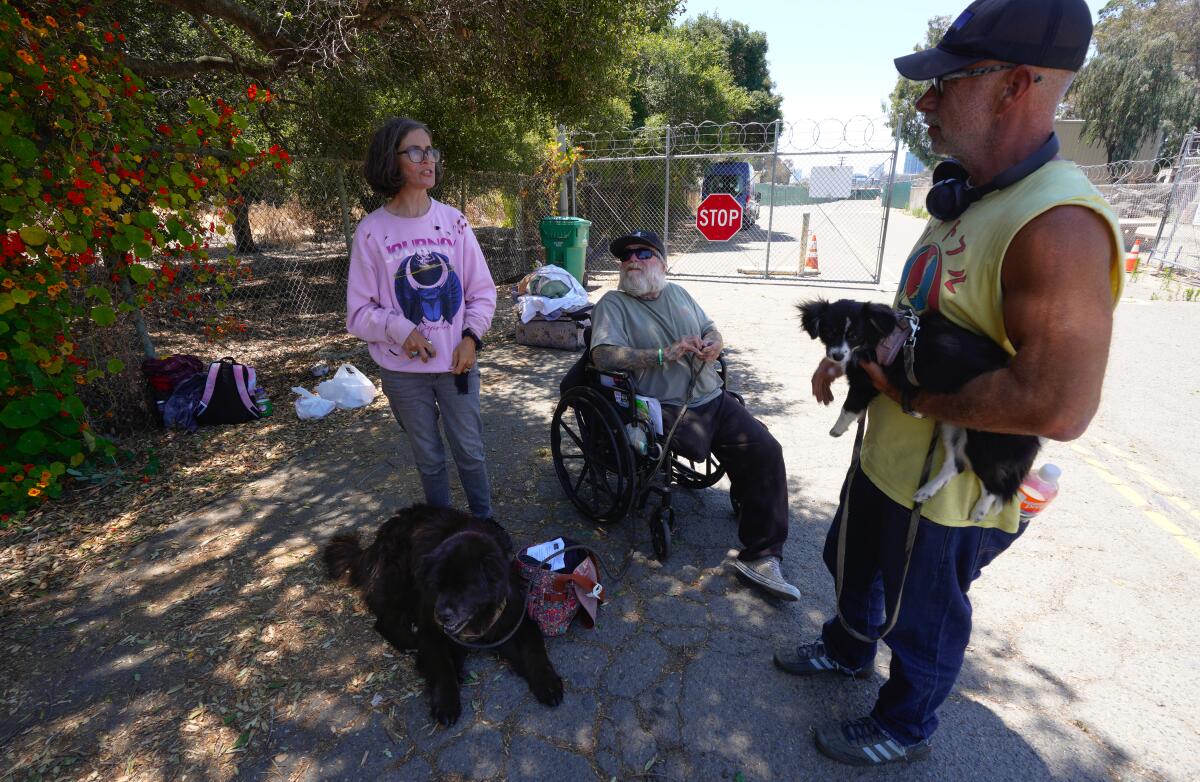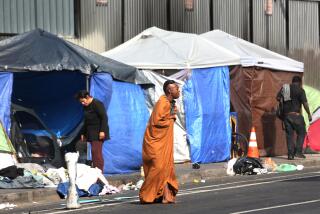San Diego opens first of two tent camps for homeless people

- Share via
SAN DIEGO — A few homeless people waited in the shade Thursday morning outside San Diego’s Central Operations Yard for a chance to move into one of the first tents at the city’s new “safe sleeping site.”
City officials plan to pitch as many as 136 tents in the parking lot in the Golden Hill neighborhood as part of an effort to move unsheltered people off downtown sidewalks. By noon, only about five people had arrived, and the tents were locked behind screened fences.
“I’ll give it a try,” said William Mulligan, 55, seated on the ground near the entrance. “It might be better than the shelter.”
Homeless since 2019, Mulligan lived in an apartment for 22 years before his luck went bad.
A restaurant worker turned truck driver, he had an accident on a wet road that left him injured, unemployed and fighting with the unemployment office. He spent some time at the city’s 17th Street shelter, but lately he’s been sleeping mostly in the downtown waterfront area.
“It’s just hard when you have to tell them you’re homeless,” Mulligan said. “One of the problems is, once you get in this situation, it’s so hard to get back out of it.”
He’d heard about the city’s tent camp from Michelle LeFever, an employee of the Street Health Program run by Father Joe’s Villages. It provides medical care including dental and psychiatric services to unsheltered people. The safe sleeping site will be operated by the nonprofit Dreams for Change, and people will be referred there by services such as Father Joe’s, People Assisting the Homeless and the San Diego Police Department.
“I’ve been out on the streets telling my clients about it,” LeFever said. “The most important thing for me is to make sure my clients are safe.”
Reports of violence among the homeless are increasing, and they need a safe place to go, the social worker said. She’d talked to between 10 and 20 “households,” some single people, some pairs and some with friends, who were interested in moving into the camp.
“They want to be off the streets, where they get harassed,” LeFever said.
“It’s horrific to hear the trauma that they have to go through having to move their stuff every day,” she said. “We pray that this works out.”
Also waiting outside the gated camp was Brian Moore, a 48-year-old bearded man wearing sunglasses and sitting in a wheelchair. He said he had one leg and one eye. Homeless for four years, he usually sleeps downtown or in Balboa Park, and he was happy about the city’s safe site.
“It’s great,” Moore said. “I’ll have a place to lay my head ... and I won’t have to worry about my stuff being stolen or getting beat up.”
Newest to the homeless experience was Jason Henning. He said he became ill and lost his job in March after working seven years in the customer care department at San Diego Gas & Electric.
He, his wife and their 12-year-old dog Romeo-Winston have been without a home for about six weeks, he said. His wife has cerebral palsy and can’t work. They spend a lot of time in the Gaslamp neighborhood.
“We don’t drink or use drugs,” he said. “It’s an adventure.”
San Diego Mayor Todd Gloria announced June 12 that the city’s Homeless Strategies and Solutions Department planned to expand its services.
“We are bringing forward a comprehensive shelter strategy with detailed proposals for the short, medium and long terms that include expanded shelter, more safe parking and safe sleeping offerings,” Gloria said at the time.
A larger safe-sleeping site with up to 400 tents is expected to open this fall in a parking lot near the Naval Medical Center. Both sites will have security, toilets and sinks, meals and access to services.
The tent camps are tied to a policy the San Diego City Council approved Tuesday to ban homeless encampments on public property.
People found camping on public property could be cited or arrested if they refuse an available shelter bed. The city’s policy follows the Martin vs. Boise federal ruling that prohibits a person from being cited for sleeping outside if no shelter beds are available.
San Diego’s new law allows some arrests even if no shelter beds are available in areas of increased public safety concerns. Those include areas within two blocks of existing shelters or schools and in city parks, riverbeds, waterways, trolley stops and transportation hubs.
Critics of the camping ban said it criminalizes homelessness and poverty. Supporters say it will improve public safety and get more homeless people into shelters, where they can receive treatment and help finding jobs and housing.
This year’s annual point-in-time count by the Regional Task Force on Homelessness found a 32% increase in the number of unsheltered homeless people in the city, with about 3,300 people living outdoors.
A recent count by the Downtown San Diego Partnership showed a record 2,100 people living on sidewalks and in vehicles just in downtown neighborhoods.
More to Read
Sign up for Essential California
The most important California stories and recommendations in your inbox every morning.
You may occasionally receive promotional content from the Los Angeles Times.










